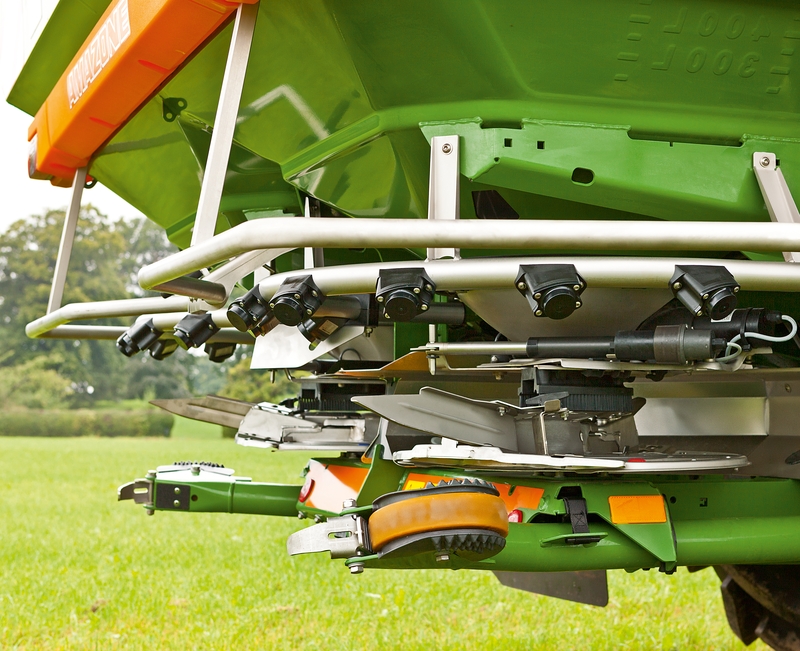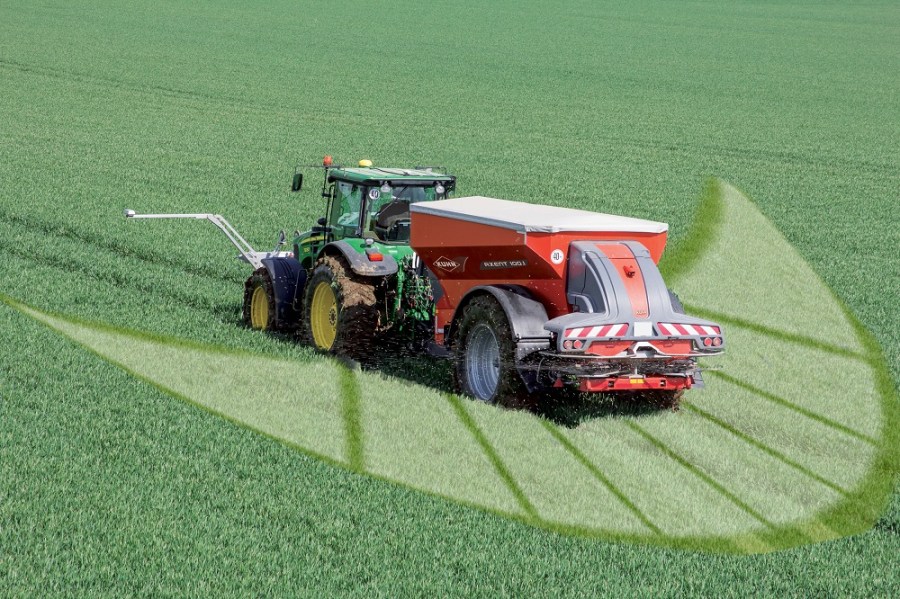Clever technologies on the latest fertiliser spreaders do a remarkably successful job in putting prills in their place. CPM rounds up recent advances.
The potential savings achieved are 5-15% in ‘typical’ European arable fields.
By Peter Hill
Accuracy in calibration; accuracy in application rate; accuracy in spread pattern.
It’s clear from these key elements of fertiliser spreading where manufacturers have focused their development energies in creating new application technologies.
The latest – and arguably most high-tech – development is the using of radar to monitor the trajectory of fertiliser prills and granules sent on their way by the spinner vanes to continuously check the evenness of distribution across the spreading width.
It makes a further contribution to earlier developments such as electronic calibration, multi-step section control with auto headland on/off and variable rate application. These contribute to a spreader operation that’s simpler and a distribution accuracy more consistent, and ultimately help make the most of fertiliser as a critical crop input.
Amazone Argus
Constant monitoring of fertiliser distribution using radar is an option on Amazone ZA-TS spreaders equipped with ISOBUS electronics.
Argus comprises an array of radar sensors above the spreading discs that check whether the trajectory of fertiliser granules is correct for the required spread width.

Argus comprises an array of radar sensors above the spreading discs that check whether the trajectory of fertiliser granules is correct
This can be affected by inconsistencies in the fertiliser, worn discs and vanes, and by working on slopes.
Deviations are automatically corrected by individually altering the feed-on point to the two discs, and the system remains active when border spreading or when the pattern is narrowed under Amazone’s GPS-Switch control.
With WindControl added it can also compensate for potential spread pattern distortion in windy conditions by collecting data from a wind speed and direction sensor.
Raised above the tractor to get a clear reading, the sensor provides the necessary data for the control software to determine whether the spreading system needs temporary adjustment.
Optimum spreader set-up for applying two fertilisers at the same time without blending is made easier with a new front-mounting option for Amazone twin disc broadcasters.
Available for the ZA-V and ZA-TS, Amazone Argus Twin, covers the practical requirements for mounting a fertiliser spreader up front, such as a lighting kit, but also control software that displays the spreading functions in reverse and automates the switch-on and switch-off points at the right place for this configuration.
The front-mounted spreader facility enables growers to use broadcasters in tandem to save blending two fertilisers and to enable each spreader to be set up with optimal settings for the characteristics of the materials.
Bredal Twin Belt
Like others in the Bredal spreader range from KRM, the F Series mounted and trailed machines deliver fertiliser by volume from hydraulically-driven rubber belts.
But instead of a single belt for both discs, these machines have individual feed belts, so the feed rate can be adjusted when the section control facility adjusts the spreading width on one side to reduce over-application in wedge-shaped areas of the field.
Spreading width can be brought in on one side only or both sides simultaneously in up to 12 steps.
This is achieved by using an electric actuator to change the position of stainless steel chutes and so alter the fertiliser feed-on point to reduce the velocity of material thrown from the disc vanes.
Kuhn Axent
The Kuhn Axent 100.1 trailed fertiliser spreader can distribute fertiliser and soil conditioning materials across 18m to 50m working widths with accuracy thanks to the Electronic Mass Control.
This measures torque at the disc drive shafts and adjusts the flow rate of material to the discs to compensate for changing humidity or inconsistencies in a mix of blended products.
With satellite positioning input, the spreader can apply materials at variable rate according to a prescription map or real-time sensing system – for nitrogen top-dressing, for example – and is available with weigh cells for frequent automated calibration checks on the move.
Different interchangeable spreading assemblies equip the machine for granular products and powdered soil conditioners such as lime and pellet fertilisers.
The latter version has bigger diameter (700mm) discs designed to spread to a distance of 15m and capable of delivering large volumes of material.
Radar sensors monitor the trajectory of fertiliser propelled from the spinning discs of Kuhn Axis H 50.2 EMC+W spreader when the Axmat Plus option is added.
The 27 sensors arranged in a horseshoe shape beneath each of the machine’s two broadcasting discs scan the distribution of fertiliser prills and granules every four seconds and ‘intelligent’ software analyses the pattern and if it deviates from the optimum will automatically fine-tune the disc feed-on point.
This compensates for changing ambient conditions and also fertiliser quality and consistency, all of which can have an impact on the spreading characteristics of fertilisers.
The Axmat Plus system therefore makes it possible to more precisely apply a wide range of fertilisers across the 3200- to 4200-litre capacity spreader’s 12m to 50m working width, while saving the time taken by operators to check and adjust the pattern manually.
Kverneland GEOspread
Wider working widths and faster working speeds are claimed for the Kverneland Accord Exacta TLX GEOspread, which comes with hoppers from 1875 to 3900 litres capacity and spreading widths from 24-40m – subject to the characteristics of the material being spread.
The key to the increased output potential is a larger CentreFlow distribution system, which allows maximum flow rate of fertiliser to be increased from the 320kg/min of existing models to the 540kg/min of the TLX.
This means that maximum flow rate can be achieved at 16km/h when spreading 40m wide; and higher speeds are possible (subject to ground conditions) when spreading to narrower widths.
The CentreFlow system comprises a bowl beneath the hopper metering outlet where the material accelerates to much the same speed as the vanes before it falls to the discs, resulting in reduced likelihood of prills or granules being shattered.
Sulky DX ECO#6
Six-step section control brings precision application technologies further down the Sulky spreader range with two models in the DX30 range – the DX30 W with capacities from 900 to 2700 litres and the DX30+ W with 1500 to 3000-litre hoppers.
The ‘W’ indicates that these versions have a built-in weigh cell with slope compensation providing continuous calibration checks and automatic hopper shutter adjustment to maintain the required application rate.
Adding the ECO#6 option with a GNSS terminal linked to the Sulky W-Vision console brings section control in six steps across the working width to minimise over-application from the patented crescent-shaped spread pattern, which Sulky engineers say more closely mimics the reality of centrifugal broadcasting.
In addition to section control, the system also provides auto shut-off and start-up of spreading at headlands, and whenever the tractor is brought to a halt.
The Sulky DX30 W spreaders already feature Tribord 2D border spreading control, engaged and disengaged from the cab, and variable rate application regulated by a prescription map.
Option for smaller units
A tractor-mounted spreader for lime, chalk, Fibrophos and similar materials is a lower-cost alternative to the trailed spreaders produced by Danish manufacturer Bredal, whose products are distributed in the UK by KRM.
The SG spreader and its electronically-controlled SGS counterpart, broadcasts from two hydraulically-driven spinners fed by a full-width belt in the base of the 500 to 2000-litre hopper.
A calibrated shutter regulates the volume of material and therefore the application rate relative to the tractor’s forward speed.
On the SG version, rate adjustment tweaks are made by hand, using a flow valve on the hydraulic belt drive; the SGS has electronic proportional control with variable application rate potential.
KRM envisages that the machine will be used by smaller growers, on hilly ground and for treatments applied to crops such as carrots and other vegetables grown in beds.
Spreader science shows savings
Spreader manufacturer Sulky-Burel put its Econov section control and headland management system to the test in a comparison with manual control by researchers at IRSTEA – the French national institute of science and technology for environment and agriculture.
Ammonium nitrate fertiliser was applied from a tractor-mounted spreader set up for a 24m working width, with the operator opening and closing the hopper shutters at headlands based on their own judgement.
With auto control, the Econov system used GNSS position data, forward speed and so on to determine shutter opening and closing points, and to close down and open up the working width as appropriate.
Sampling determined that while manual control achieved 45% evenness of application within +/-15% of the target dose rate, that figure increased to 68% with the Econov system.
Under- and over-dosing was virtually eliminated and the total quantity of fertiliser applied was reduced by 9% – from 1515kg under manual control to 1380kg with the automatic system.
Sulky-Burel notes not only the potential for input cost savings but also the beneficial effects on the crop of optimising fertiliser dosage, and on the operator of automating the more challenging aspects of broadcaster operation.
Pattern refinements
Manufacturers have been remarkably successful at developing effective section control for spinning disc broadcasters given the challenge of modifying their fan-shaped output and the way the dosage is built up in multiple layers.
Basic systems bring the spread pattern in from one side or the other, while more advanced versions can manipulate the spreading width on both sides simultaneously to minimise over-treatment.
And the level of definition has increased enormously – from just four sections across the whole width to as many as 128 sections or infinitely variable depending upon the level of control software sophistication.
The potential savings achieved are clearly dependent upon the size of fields and their shape but 5-15% in ‘typical’ European arable fields is a common claim.




